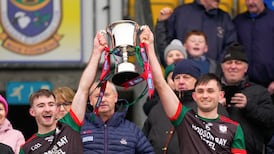One of the best moments in the entire history of Dublin belongs to the opening seconds of Phil Lynott’s lush and irrepressible ode to his home city, Old Town.
The accompanying video has Philo striding across the Ha’penny Bridge, easy with the fact that he is, by some distance, the last word in whatever rock godliness is supposed to be. He looks fantastic and as he glides through the city on a fresh day in 1982, it lights up around him.
It’s not so much a pop video as three minutes of sound and vision perfection. And it’s hard not to think of it anytime you cross or even see the Ha’penny Bridge – when crawling up the quays in grinding traffic on those muggy summer days when people from outside counties visit the capital to see their team play in Croke Park where, these days, sooner or later, they get beaten by Dublin.
The unexpected row over the hanging of the ‘Up The Dubs’ banner across both rails of the historic bridge has become the chief topic of debate in the city since Jim Gavin’s team swept to their fifth league title in six years.
For some, the banner is a tacky looking eye-sore needlessly defacing one of Dublin’s most beloved structures.
For others, it is a light-hearted and visible celebration of a team that has already singled itself out as one of the most remarkable in the long history of the GAA.
Nobody is saying they don’t like the Dubs. But some people are saying they just don’t like the banner. It’s a matter of taste, with the Dublin Civic Trust fronting a dignified if despairing protest against the presence of the banner placed on the bridge by Dublin City Council, whose argument is that the banner “brightens up the city.”
In Monday morning’s radio debate on RTÉ, a spokesperson for the Council went to pains to stress the temporary nature of the banner. Much like, say, the moving statues in the west of Ireland of the 1980s, it appears only every so often: “if Dublin are in a final – which has, admittedly been a more frequent occurrence in recent years.”
Oh, you can imagine wry nods of appreciation across the strongholds of Kerry and Meath at this kind of highly nuanced and sophisticated trolling. For decades, the colouring-in of local livestock and the decking out of towns, villages and architectural wonders was the happy pastime of counties who habitually won All-Irelands and other trophies in the years when Dublin could not. You couldn’t really miss the fact that a county was in a big final because it looked as if a gigantic child had taken two crayola markers in the designated county colours and scribbled over every inch of it.
In Dublin, it works differently. The Dublin senior football team has never been more visible – it has also never been less talkative but that’s a different issue. But for all that, it is still incredibly easy for the achievements of the team to become lost or drowned out in the diversity and sheer energy and size of the city.
In his Dublin jersey, in Croke Park, Con O’Callaghan is a star. Walking across the Ha’penny Bridge, though, he’s just another young guy in a young city. So there is an understandable instinct to mark what is an incredible GAA era in a county that had, for years, struggled with the complex task of transferring the potential of its population into on-field success.
But is this particular banner the way to do it? Doesn’t the team deserve slightly more? One of the most brilliantly conceived public tributes to any football team was an old shed smack on the Galway-Mayo border on the N7, just down the road from Ballindine. The shed was painted green and red and proclaimed Mayo: All-Ireland Champs 1951, as if that date was in the recent past. It was simple and evocative and, sitting there against the backdrop of empty fields, asked a thousand questions of passing motorists.
Does the Ha’penny Bridge banner do any of that? It’s hard to disagree with the argument that it’s not the most brilliantly conceived moment in the history of design – or even the history of banners.
If the DCC wish to decorate the city with iconography celebrating the county team, couldn’t it explore more imaginative ways of doing so? Couldn’t they light up landmarks in sky and navy blue? Couldn’t they commission artists to ‘brighten up the city’ with murals portraying everything that makes urban (and suburban) GAA different from the scene across the country? What artist couldn’t make splendid city art out of the face of Kevin Heffernan? What artist wouldn’t be up for making art out of a 60-foot silhouette of Diarmuid Connolly?
Forget, for a moment, that the restarts of Stephen Cluxton are an art installation in their own right. There is limitless potential. Couldn't they even come up with a banner that hangs below the rails of the Ha'penny – something less busy and loud but still proclaiming what has become the essential city victory cry: Up The Dubs?
Thousands of tourists visit the city every week without any real idea of the GAA or that Dublin is enjoying a special time as a Gaelic football phenomenon. They are a source of immense pride across Dublin: that that pride should be mirrored in the cityscape is no bad thing.
Dublin will play for its fourth All-Ireland title in a row this summer. Among the other competing counties, there will be little sympathy towards this row over the aesthetics of the Dubs banner. If anything, it’s a sign of how well everything is going for Dublin GAA.
For other counties, its not the damn banner that’s the problem. It’s the Dubs themselves. Are they ever going to stop? And why doesn’t the Hill crowd sing Old Town anyway?















